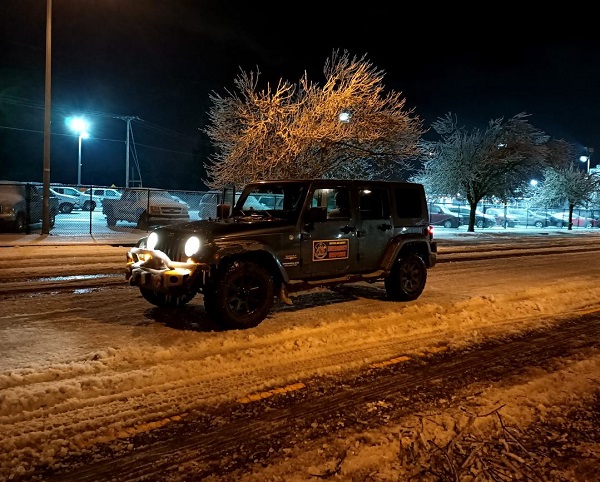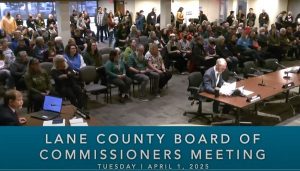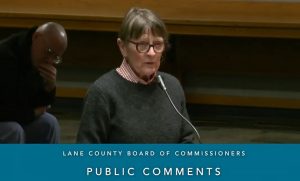Central Aid Agency again proves itself as a jack-of-all-trades in a disaster
10 min read
Among the many unsung heroes of the ice storm, the versatile team at Central Aid Agency. Their work allowed the Carry It Forward shelters to operate throughout the storm in Cottage Grove. Describing their deployment over the MLK weekend:
Ben Bower: Well, the first conversation actually occurred on Friday, which was the day before the weather actually set in, and there was some coordination going on between COAD (Community Organizations Active in Disasters) and Lane County and City of Eugene. And so, we started thinking about going on standby at that point.
[00:00:31] On Saturday, the city of Eugene officially requested us go on standby for potentially providing transportation. So, we went on standby then and there was some coordination calls. And then Sunday came around and Sarah Koski actually reached out to me directly.
[00:00:47] Sarah previously was heavily involved in the COAD, and she was the COAD chair for a while, and so that’s how I met her, actually. And she’s also really involved in the community, and so she has a lot of connections. And so I think that she in her other roles came across this need and then realized from her days in the COAD that there might be an organization available to fill that need.
[00:01:12] And so she just kind of put those two together. And although we typically get deployed by government entities, I would say that’s about like 80% of who deploys us or the COAD, which is kind of in that same realm. We don’t actually have to be deployed by them. We can be deployed by anyone that makes a request, including individuals.
[00:01:31] So. Sarah put the two together and then she had gave our contact information to Chris, who’s with Carry It Forward. He filled out a resource request through our website. We have a page where people can request resources. And that was kind of the starting point of this relationship. And, you know, in situations like that, it’s kind of like a first-come-first-serve kind of thing.
[00:01:53] We had been put on standby by other agencies, but no requests had come through. So this was the first request that came through for a legitimate need that we could fill. And so we do, if we have multiple requests, we kind of triage them where life safety stuff gets the highest priority.
[00:02:09] And said, ‘Hey, we have a need for this organization that is directly supporting the homeless community, and they need to get people to and from their job sites, and especially the one in Cottage Grove.’
[00:02:21] And so she kind of put the pieces together on that, and we ended up activating for the first time Sunday evening, and initially our commitment was, they were going to 12-hour shifts, so we were doing the shift changes in the morning and evening. So that’s kind of how that all started.
[00:02:37] John Q: By transporting Carry It Forward staff, those shelter sites were able to remain open throughout the storm.
[00:02:43] Ben Bower: Cottage Grove was relatively isolated from Eugene Springfield metro area because of all the weather conditions, you know, the back roads were not passable.
[00:02:53] I-5 had its own problems and so, and Cottage Grove was out of power. So that made this site pretty isolated. But also those folks are are vulnerable because if we weren’t able to get resources to them, they would have had to evacuate that site, which means those people have to go somewhere else and shelters were already full or understaffed.
[00:03:14] So, this was a really great solution because it allowed them to just kind of stay where they were, and they were able to get a generator from the state after day two or three. And so that really helped too because then there was power at this location and one of our tasks was we actually refueled the gas cans for that generator and helped them refuel it.
[00:03:33] So it was a really great thing to be a part of and definitely a need that the community had.
[00:03:40] There was a chain-up requirement on I-5, which, you know, it’s not super common. And so they don’t have nice little chain-up spots like they do on the passes. So what a lot of trucks were doing was, you know, they’re starting to realize, ‘It’s slippery, I need to chain up.’
[00:03:58] But they’re not really getting over to the shoulder. And so as a result, you know, people are backing up. And as soon as those trucks get chained up, they’re going to leave. But the trucks behind them are now in the process of chaining up. And so it created this flowing problem. And that’s why I-5 jammed up, because we actually saw that happen.
[00:04:12] We were typically able to get to Cottage Grove using I-5 southbound. There was only one morning where southbound was starting to get a little jammed up. But ODOT was really on top of their game and tried to do their best to get that fixed. So we started looking at alternatives that we could use instead of I-5.
[00:04:31] And Territorial (Highway) was kind of out of the question or, you know, Lorane Highway because it’s way remote. So we’re thinking lots of trees down. There’s a lot of corners out there that drop off. And so that was high risk. That was our tertiary plan.
[00:04:46] So we thought about what about (Highway) 99? And according to TripCheck, 99 was closed and a couple of semis actually did try it on one of the days that I went and they were having trouble with it.
[00:04:57] There’s a lot of trees down, but it was possible for a small car, but on TripCheck, it still said it was closed. So a lot of people weren’t going that route. We thought, ‘It’s worth a shot.’ So we ended up using 99 quite a bit, actually, especially going northbound out of Cottage Grove.
[00:05:11] And that worked out well for us, especially because on Wednesday, I think a crew went through. I don’t know if it was locals or power company, but they cleared out most of the trees. And so it was really quite passable. You look for oncoming traffic and you go slow and we are all trained in traffic control so we could do that if needed but we didn’t actually need to because everyone was very kind and courteous and we just kind of signaled at each other to, you know, it was like a one-way kind of place and then took turns and it worked really well.
[00:05:40] And that went until Wednesday or Thursday. Well, so Wednesday night, we actually activated a second team.
[00:05:48] We like to staff two people to a vehicle. You have the driver who just focuses on driving, and then you have a crew member who does communications, document logging, that kind of thing. So they activated on Wednesday evening and worked all the way until I think they secured around 6:30 Thursday morning. And then they were doing runs in Eugene-Springfield area for the same organization, Carry It forward.
[00:06:13] So then we ran the last run for Cottage Grove on Thursday morning and people were going to have to go back to work. We had been deployed for four days at that point and 20 hours continuously, from Wednesday evening to Thursday morning. And so at that point, people are like, ‘We got it.’
[00:06:30] We got to take a break and we have to go back to work and stuff like that. So that’s when weather was getting better at that point. So we coordinated with them and said, ‘We’re not going to be able to do anything after about noon on Thursday.’ And so that’s okay. And they said, ‘That’s fine. They can make it work.’
[00:06:45] So that was what our deployment looked like.
[00:06:48] John Q: The Central Aid Agency often provides transportation support.
[00:06:53] Ben Bower: We are a jack-of-all-trades organization. We offer a lot of different capacity. So we’ve done, I’d say, probably transportation is like 50 or more percent of what we do because we’re one of the few organizations that specifically train for inclement weather transportation services.
[00:07:10] But we’ve also done security services, we’re licensed to do that, and also evacuations. So we’ve done evacuation notices several times, mostly for wildfires. And then during Cedar Creek, we also did staff the emergency evacuation point. And then also working in the shelter, because Red Cross needed assistance.
[00:07:30] They didn’t have medically trained people to stay in the shelter, and their people were at the maximum deployment limit. So they said, ‘Hey, you know, you guys are medically trained.’ I said, ‘Well, yeah, we don’t have medical direction. So even though I’m like an EMT, I can’t be an EMT without medical direction, but we have first aid training. So we can do basic first aid stuff if you’re cool with that.’
[00:07:54] And then they’re like, ‘Yeah, we can do that.’ So I was actually the point of contact for Health and Human Services overnight for that shelter. So that was interesting because we saw the evacuation piece. We saw the rally point piece, the TEP, Temporary Evacuation Point, and then the actual shelter operations.
[00:08:10] That was interesting and made us scratch our heads a little bit, that maybe in the future, something that we want to develop within our organization is mass care support. Because that is definitely a need we’ve seen in the community, and although Red Cross is great, if you have a large-scale disaster, they get tapped out too, because they only have so many resources. But yeah, transportation, I’d say, is a lot of what we do.
[00:08:29] Our special vehicle operations team has different classifications of vehicles based on the vehicle type, whether it’s, like, a Jeep or an ATV or something like that.
[00:08:38] And then there are subcategories based on what equipment is on your vehicle. So we recommend that people get things like extra clearance underneath your vehicle, winches, recovery gear in case you have to get unstuck. And then we send our drivers through a training program where we put them on different environments.
[00:08:58] So you have to prove that you’re a competent driver on pavement, on trails / dirt and gravel, snow, and sand. And if you do all four, then you become what’s called an expert vehicle operator. And so we currently have two expert vehicle operators and another one who’s in the process of. So doing all that, because during the summertime, what we do with this team, because if we’re not deployed on fires, we’ll go out and do ATV assistance on the dunes.
[00:09:28] And it’s really good training for us practicing driving in that kind of a terrain and also helping people who are in need. And so that experience directly relates to driving on ice and snow because all low traction is pretty much the same in concept.
[00:09:41] So we do carry chains. We don’t really do studded tires that much because we prefer to air down. It’s a much more applicable solution to different kinds of environments where like studs are pretty much only good for pavement. We have found ways to deal with those kinds of environments, but our drivers are really, really competent.
[00:10:01] And like I said, we practice quite a bit to make sure our skills are sharp.
[00:10:05] That’s what our thing is, is we want to provide people who are well trained, they can plug into pretty much anywhere there’s a need. And so we really emphasize that versatility. We emphasize cross-training with an organization and the mindset of: ‘We will go wherever we’re needed, if we can plug into that.’
[00:10:23] John Q: The Central Aid Agency is always looking for new volunteers.
[00:10:28] Ben Bower: I think our biggest need if people want to get involved, monetary donations are always great because then we can get equipment and training. But if people want to get involved and get trained so that we have more capacity, if they have that, what we call ‘the servant’s heart,’ they want to get out in the community and serve, come check us out.
[00:10:43] Because we have, the need for our organization continues to grow. And so we’re always looking for people who are motivated and want to serve their community.
[00:10:52] All that information is available on our website CentralAidAgency.org. In addition to that, people can always show up at our meetings. So we meet once a month on the second Thursday of the month from 7: 30 to 9 p.m. at our headquarters in Junction City.
[00:11:07] So 7:30 is typically the meeting start time. And then we do a training once a month and it’s typically the Saturday following the meeting, but it depends. Because if we’re doing something with another organization that can change it a little bit, but typically it’s the Saturday following the meeting and the meetings are the second Thursday of the month.
[00:11:26] Some of our trainings, depending upon what we’re doing, can be audited as well, with no commitment. So yeah, come check us out, ask questions, see what it feels like and if it’s a good fit for you.
[00:11:37] We work with city of Eugene fairly regularly. We did an exercise with them in December, which was really good, an urban search and rescue exercise. We are currently forming a relationship with the Oregon Disaster Airlift Response Team, which is an air operations organization that’s just starting out, but they have a lot of pilots that are interested. And so we’re forming a relationship with them. We’re going to be doing exercise with them in June.
[00:12:01] We’ve done some work with Lane County Search and Rescue. We did a mutual aid assistance for Search and Rescue on the last day of our deployment for ‘Snowpocalypse.’ And we went up to Westfir to do welfare checks. And Westfir had tons and tons of downed trees. That was when Highway 58 was shut down. And so we started to realize that, ‘Hey, we need to talk about how to cut trees.’
[00:12:22] Yeah, we really, within our own organization, we strive for efficiency and excellence. That’s some of the things that are really part of our core. And that really shows through because even though we’re a small organization, we are able to accomplish a lot.
[00:12:38] John Q: Among the unsung heroes of the MLK weekend ice storm, Central Aid Agency. Check out their website and learn how to volunteer at CentralAidAgency.org.






